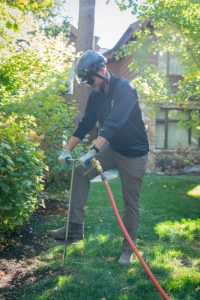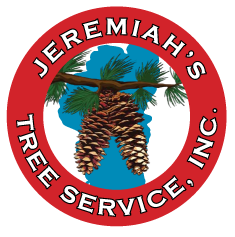
Lake Tahoe’s stunning landscapes are characterized by towering pines, vibrant aspens, and lush fir trees. However, these trees face unique environmental challenges due to the region’s high altitude, rocky soils, and long, harsh winters. One crucial step in maintaining the health and vitality of your trees is spring fertilization.
Spring tree fertilization in Lake Tahoe, CA helps replenish essential nutrients lost during the winter months, supports new growth, and strengthens trees against pests, diseases, and drought. As the snow melts and the soil begins to warm, trees enter their active growth phase, making spring the ideal time to provide the nutrients they need to thrive.
In this guide, we’ll explore why fertilizing your trees this spring is so important, when to schedule the application, how to choose the right fertilizer, and why partnering with a trusted local expert like Jeremiah’s Tree Service can make all the difference.
Why Tree Fertilization Matters in Lake Tahoe’s Unique Climate
Lake Tahoe sits at an elevation of over 6,000 feet, with soils that are often sandy, rocky, and low in essential nutrients. Trees in this environment must work harder to establish strong roots, absorb nutrients, and maintain healthy growth.
Several factors contribute to the need for regular tree fertilization in Lake Tahoe:
- Nutrient-Depleted Soils: The region’s soils are naturally deficient in nitrogen, phosphorus, and potassium—three key nutrients for tree growth. Snowmelt and rainfall can further deplete these nutrients by leaching them from the soil.
- Stress from Winter Conditions: Harsh winters cause trees to go dormant to conserve energy. As they re-enter their growth phase in spring, they need additional nutrients to recover from this seasonal stress.
- Short Growing Season: Lake Tahoe’s growing season is shorter compared to lower-elevation regions. Fertilizing in spring gives trees the nutrients they need to maximize growth during the limited warm months.
- Pest and Disease Resistance: Healthy, well-fertilized trees are better equipped to resist common Tahoe pests like bark beetles and diseases like root rot.
Proper fertilization ensures that your trees remain vibrant and resilient despite these challenges. A customized fertilization plan from Jeremiah’s Tree Service can help address your landscape’s specific needs.
How Tree Fertilization Works in Spring
During the winter months, trees enter dormancy, slowing their metabolic processes to conserve energy. As temperatures rise in spring, trees shift into active growth, demanding higher levels of nutrients to support new buds, leaves, and root development. Applying fertilizer at the right time ensures these nutrients are readily available when trees need them most.
Soil testing is a critical first step in the fertilization process. By analyzing soil samples, arborists can determine existing nutrient levels and pH balance, helping to select the most appropriate fertilizer blend for your property.
Best Time for Spring Tree Fertilization in Lake Tahoe
Timing is key when it comes to tree fertilization, especially in Lake Tahoe’s climate. The ideal window typically falls between late February and April, depending on weather conditions and soil temperatures.
Key Timing Considerations:
- Soil Temperature: Trees begin to absorb nutrients when soil temperatures reach approximately 40°F. Applying fertilizer too early, while the ground remains frozen, can result in wasted nutrients.
- Snowmelt and Moisture Availability: Snowmelt provides the moisture necessary for nutrient absorption. Fertilizing shortly after snowmelt ensures nutrients reach the root zone effectively.
- Tree Growth Stage: Fertilizer should be applied as trees transition from dormancy to active growth. Early fertilization supports leaf and root development during this crucial period.
- Avoid Late Applications: Fertilizing too late in the season can stimulate new growth that may not harden off before winter, leaving trees vulnerable to frost damage.
Consulting with Jeremiah’s Tree Service ensures your fertilization schedule aligns with these critical factors, maximizing nutrient uptake and tree health.
Choosing the Right Fertilizer for Tahoe Trees
Selecting the right fertilizer is essential to achieving optimal results. In Lake Tahoe’s nutrient-poor soils, the choice often depends on the tree species, soil composition, and specific growth goals.
Types of Fertilizers:
- Organic Fertilizers:
- Derived from natural sources such as compost, manure, or bone meal.
- Release nutrients slowly as organic matter decomposes.
- Improve soil structure and microbial activity over time.
- Synthetic Fertilizers:
- Manufactured to provide precise nutrient ratios.
- Deliver nutrients more quickly but require careful application.
- Ideal for trees showing immediate signs of deficiency.
Fertilizer Formulations:
- Granular Fertilizers: Applied to the soil surface or incorporated into the soil. Best for slow, long-term nutrient release.
- Liquid Fertilizers: Applied directly to the soil or foliage. Useful for rapid nutrient delivery.
- Slow-Release Fertilizers: Provide nutrients gradually over several months, minimizing the risk of nutrient leaching.
The right choice depends on the tree’s age, species, and health status, along with the property’s soil conditions. Jeremiah’s Tree Service conducts soil tests and tree health assessments to recommend the most suitable fertilizer for your landscape.
Weather and Environmental Factors to Consider
Lake Tahoe’s unique climate patterns significantly influence tree fertilization strategies. Understanding these factors helps ensure your trees receive nutrients when they can absorb them most effectively.
Key Environmental Factors:
- Snowpack and Snowmelt: Tahoe winters often leave behind thick snow layers that gradually melt in spring. Fertilizing after snowmelt ensures nutrients penetrate the soil and reach tree roots.
- Spring Rainfall: Spring showers aid in nutrient distribution and absorption. However, heavy rain can also wash fertilizers away if applied too soon.
- Temperature Fluctuations: Late frosts and temperature swings can stress trees and affect nutrient uptake. Arborists monitor weather patterns to adjust fertilization timing accordingly.
- Soil Composition: Lake Tahoe soils are often sandy and drain quickly, increasing the risk of nutrient leaching. Fertilizer application techniques must account for these conditions to maximize effectiveness.
Properly timed and applied fertilization, based on these environmental factors, helps trees grow vigorously throughout the season.
Soil Testing: The Foundation of Effective Fertilization
Soil testing is a critical step in any successful fertilization program. Without understanding the existing nutrient profile, applying fertilizer becomes guesswork and may lead to nutrient imbalances.
The Soil Testing Process:
- Sample Collection: nSamples are taken from several locations around the tree’s root zone to ensure accurate results.
- Laboratory Analysis: Tests measure levels of macronutrients, micronutrients, pH, and organic matter content.
- Customized Recommendations: Based on the results, arborists recommend specific fertilizer types and application rates to address deficiencies and optimize tree health.
Common Soil Issues in Lake Tahoe:
- Low nitrogen and phosphorus levels.
- High soil compaction, limiting nutrient uptake.
- Alkaline soil pH, which can restrict micronutrient availability.
Jeremiah’s Tree Service offers professional soil testing and fertilization services to help your trees flourish.
Spring Tree Care Checklist for Lake Tahoe Residents
Spring tree care involves more than just fertilization. Follow these steps to give your trees a strong start to the growing season:
- Schedule a Soil Test: Identify nutrient deficiencies and determine the best fertilizer for your trees.
- Apply Fertilizer Early: Fertilize as soon as soil temperatures allow, prioritizing slow-release formulations for long-term benefits.
- Prune Dead or Damaged Branches: Remove branches affected by winter weather to promote healthy growth.
- Inspect for Pests and Diseases: Watch for signs of bark beetles, scale insects, and fungal infections.
- Mulch Around Tree Bases: Apply mulch to conserve moisture, regulate soil temperature, and improve soil quality.
Regular tree care, combined with professional fertilization, keeps your landscape healthy and beautiful year-round.
Why Choose Jeremiah’s Tree Service for Spring Tree Fertilization?
Jeremiah’s Tree Service is a locally trusted provider of tree care services in Lake Tahoe, CA. Our team of ISA-Certified Arborists understands the unique challenges of tree care in the region and offers tailored fertilization programs to meet your landscape’s needs.
What Sets Us Apart:
- Local Expertise: Decades of experience caring for Tahoe’s native and ornamental trees.
- Customized Fertilization Plans: Soil testing and species-specific solutions to promote healthy growth.
- Environmentally Conscious Practices: We prioritize eco-friendly fertilizers and sustainable tree care methods.
- Comprehensive Tree Care: From fertilization to pruning, pest management, and health assessments, we offer complete tree care services.
Let us help your trees thrive this spring with our professional fertilization services.
FAQs: Spring Tree Fertilization in Lake Tahoe, CA
When is the best time to fertilize trees in Lake Tahoe?
The best time to fertilize is from late February to April when soil temperatures reach around 40°F and trees begin their spring growth phase.
What type of fertilizer works best for Tahoe’s trees?
Slow-release fertilizers with balanced nitrogen, phosphorus, and potassium levels are ideal, though soil testing helps determine the best formulation for your property.
How often should I fertilize my trees?
Most trees benefit from annual fertilization in spring. However, species with higher nutrient demands may require additional applications.
Can fertilization help protect trees from pests?
Yes. Healthy, well-nourished trees are more resilient against pests like bark beetles and aphids.
Do all trees need spring fertilization?
Not necessarily. Mature, established trees in nutrient-rich soils may not need annual fertilization, while younger or stressed trees often require more nutrients.
How can Jeremiah’s Tree Service help with tree fertilization?
We provide soil testing, fertilizer application, and ongoing tree care to keep your landscape healthy year-round.
Protect Your Trees’ Health This Spring
Spring tree fertilization in Lake Tahoe, CA is a vital part of maintaining a healthy, vibrant landscape. By replenishing essential nutrients lost over winter, you give your trees the support they need to grow, resist pests, and withstand environmental stress.
Partnering with Jeremiah’s Tree Service ensures your trees receive expert care based on the latest arboricultural practices and a deep understanding of Tahoe’s unique ecosystem. Contact us today to schedule a free estimate, and develop a customized fertilization plan for your property.
Invest in your trees this spring—they’ll reward you with years of beauty, shade, and ecological benefits.
